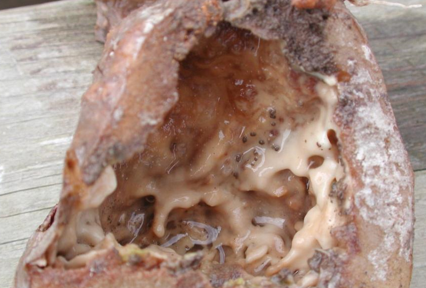Who goes there?
22 mars 2024
Seed supply and quality varies every year, and sometimes you have to take what you get. Taking stock of seed before it goes into the ground allows you to evaluate what disease battles you may face at emergence, during the season, or in harvest.
Below is a summary of common seed-borne diseases.
1) Soft rot (seed piece decay, bacterial soft rot, black leg):

Soft rot is an opportunistic infection meaning it usually enters through a wound or as a secondary infection to another disease. Soft rot is commonly found on seedpieces that have been cut and have not been able to suberize due to poor conditions. Cutting infected seed exacerbates the spread of this condition through a seed lot.
In eastern Canada, soft rot occurs when planting fresh-cut seed in cool, wet soil conditions or due to improper storage conditions. It can also be more common when there are significant temperature differences between seedpieces and soil when planting. Stand loss is the primary implication, but there is also a risk of foliar infections, which can spread the issue further with wet weather and heavy dew. Learn more about soft rot.
2) Fusarium dry rot (dry rot):
 One of the most common seedpiece diseases, Fusarium dry rot, typically appears in storage and can significantly affect the vigor of seed. Planting infected seed raises the risk of decreased stand and diseased daughter tubers, which may in turn affect final marketable yield. Fusarium dry rot also provides an “in” for secondary infections like soft rot. Learn more about Fusarium dry rot and management methods.
One of the most common seedpiece diseases, Fusarium dry rot, typically appears in storage and can significantly affect the vigor of seed. Planting infected seed raises the risk of decreased stand and diseased daughter tubers, which may in turn affect final marketable yield. Fusarium dry rot also provides an “in” for secondary infections like soft rot. Learn more about Fusarium dry rot and management methods.
3) Rhizoctonia black scurf:
 Also known as “the dirt that doesn’t wash off,” Rhizoctonia black scurf is commonly found in table stock potatoes and creamers. This disease is very common as once it is present in a field, it can remain there for years. Rhizoctonia found on seed piece seed pieces or in soil can and can infect daughter tubers. This disease can also be brought in on rotation crops such as soybean and corn, prompting many growers to apply crop protection products preventatively. Learn more about Rhizoctonia black scurf and management techniques.
Also known as “the dirt that doesn’t wash off,” Rhizoctonia black scurf is commonly found in table stock potatoes and creamers. This disease is very common as once it is present in a field, it can remain there for years. Rhizoctonia found on seed piece seed pieces or in soil can and can infect daughter tubers. This disease can also be brought in on rotation crops such as soybean and corn, prompting many growers to apply crop protection products preventatively. Learn more about Rhizoctonia black scurf and management techniques.
4) Silver scurf
 Silver scurf displays as the name implies – as a silvery scuff mark on the skin of a potato. It can also be confused with black dot, which shares this characteristic. The fungus primarily spreads by tubers, including seedpieces, that infect soil. Silver scurf is primarily an issue when selling in the table market due to the appearance of infected skins. Variety and harvest date often play into the amount of infection seen in a harvested crop. Learn more about managing silver scurf.
Silver scurf displays as the name implies – as a silvery scuff mark on the skin of a potato. It can also be confused with black dot, which shares this characteristic. The fungus primarily spreads by tubers, including seedpieces, that infect soil. Silver scurf is primarily an issue when selling in the table market due to the appearance of infected skins. Variety and harvest date often play into the amount of infection seen in a harvested crop. Learn more about managing silver scurf.
5) Black dot
 Black dot, often confused with silver scurf, appears as a silvery infection on tubers. With close observation, sometimes with a magnifying glass, small black dots called sclerotia can be found in the center of the silvery patch distinguishing this fungus from silver scurf. While black dot does not kill plants outright, it does affect overall plant health as the infection can be taken up by roots and move upward to foliage. Learn more about the implications of black dot and how to control it.
Black dot, often confused with silver scurf, appears as a silvery infection on tubers. With close observation, sometimes with a magnifying glass, small black dots called sclerotia can be found in the center of the silvery patch distinguishing this fungus from silver scurf. While black dot does not kill plants outright, it does affect overall plant health as the infection can be taken up by roots and move upward to foliage. Learn more about the implications of black dot and how to control it.
6) Late blight
Late blight on seed can be confused with pressure bruising, however a tell-tale sign is seeing a sunken, irregular bruise concentrated around the eyes. Quite often there are no symptoms over the surface which can put the stock at risk as disease can spread to healthyseed pieces during the cutting and treating processseed pieceseed pieces. When cut open, the seedpiece will appear blotchy and does not have a defined edge as a pressure bruise does. Learn more about seed-borne late blight and management options.

Looking for information on other potato pests? Check out our potato pest page.